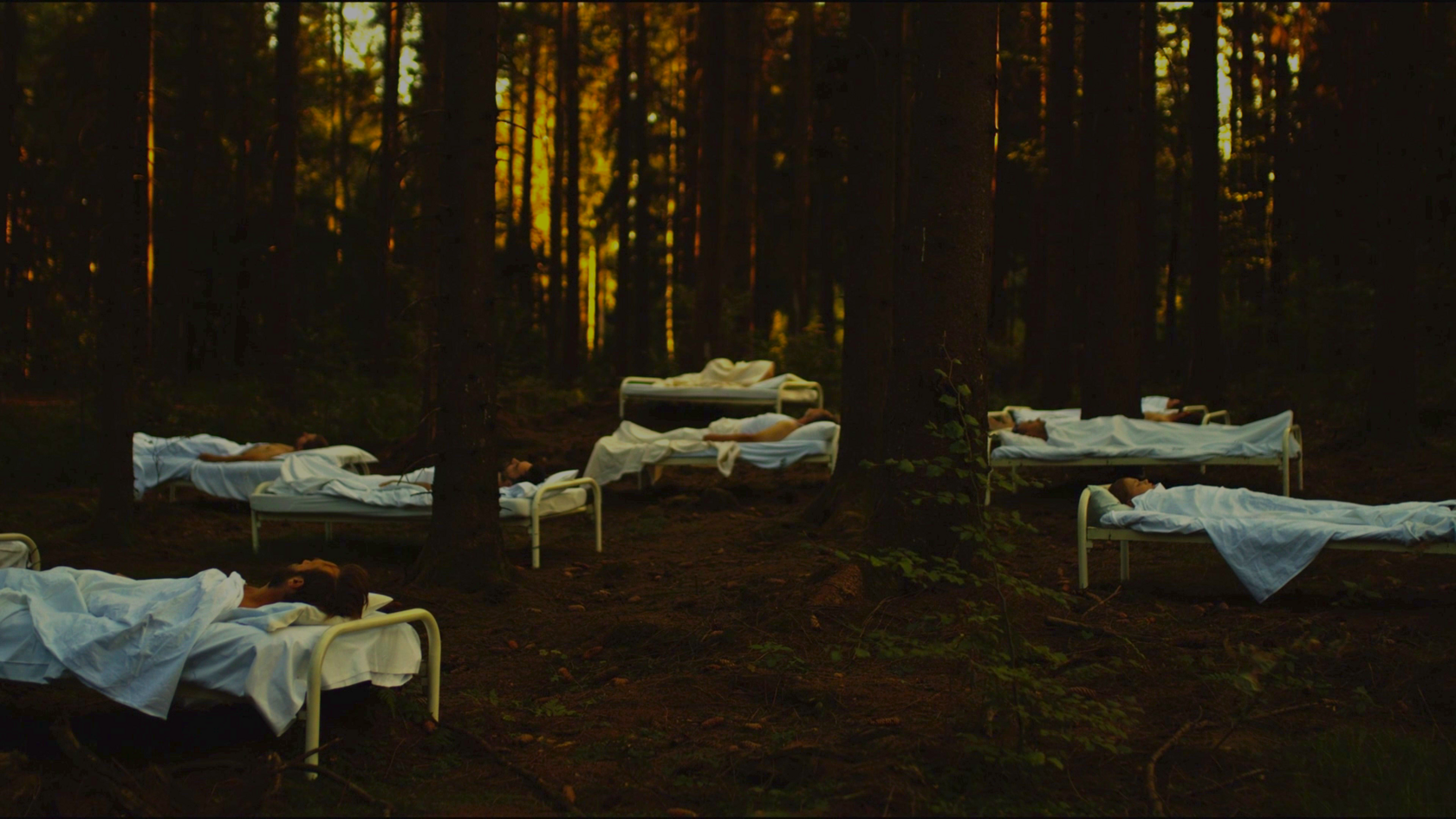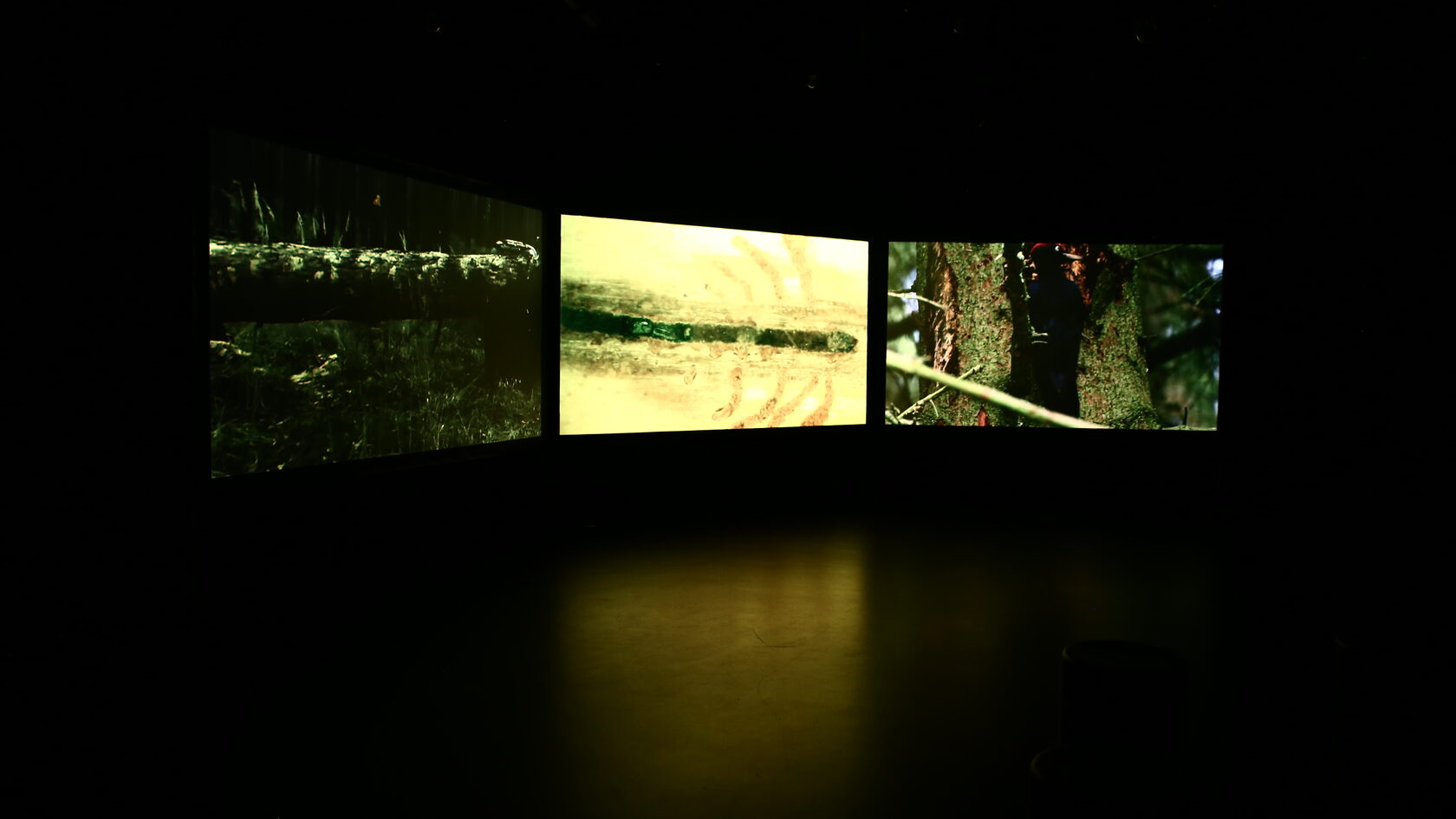LIMBO. THE EARTH IS HARD
(2022)
video installation
video installation
EXTENDED SYNOPSIS
Sous le soleil de mes cheveux blonds,
Limbo. The Earth is hard
Limbo's three screens, the recitation of ecstatic poems by Trakl, and the drone-based music occasionally interwoven with Mahler – Oh Mensch! Gib Acht! – inevitably evoke, if not a religious atmosphere, then at least a meditative state. However, this contemplative mood gets ruined from the beginning, as downright disgust overwhelms the spectator upon hearing vomiting sounds that accompany a woman's relating of a story about eating eggs – the first in a series of disturbing scenes and images. As visceral, deeply felt this emotion may be, through the three screens' various ways of playfully interacting, the alternating between scenes from a field hospital in a wood, medical imagery, footage from nature documentaries, and satellite images of a burning planet, one also gets a feeling for the world Limbo depicts. This world finds itself, indeed, in limbo, that is somewhere in between the remainders of a world as one supposedly once knew it, and a catastrophic end of time that is taking place. This 'end of time' should be taken quite literally for the natural cycle of birth, life, decay and death has stopped, aptly indicated by the film's subtitle, The earth is hard. One sees bedridden men, obviously sick but unable to die, and therefore not ready to be returned to the earth and its perpetual recycling work. Whereas once human beings craved to postpone, eventually overcome death, in Limbo death has become uncertain, postponed until further notice, to the effect that one does not stop dying all the time. More precisely, not so much human beings but rather death itself has become immortal. In Limbo, death is not a painful or consoling event taking place, but the agony of being endlessly alive, that is undead. In such a world, the atrocious story told by one of the nurses feels like a relief, for it involves at least a before and an after, that is the time needed for a minimal, albeit delayed yet growing distance to an eventually disappearing trauma.
As such, Limbo – although taking its cue from a transhistorical nexus of repulsion and fascination for sexual, procreating, that is persisting and insisting life – refers to contemporary, 21st century predicaments (climate change) and nightmarish fantasies (the inability to die). This raises the questions how to understand and deal with this superfluous, bare life in its political, ecological, and anthropological dimensions, whether there is anything to learn from the catastrophes both before and behind us, and where to look for a possible answer. Limbo does not tell us where or how to look for such an answer but makes the entertaining suggestion to start to read the traces, from those left behind in decaying trees by the bark beetle – which helps the decomposition and recycling of dying wood – to the words written down by a dead poet, teaching us to die before it is too late.
Dominiek Hoens
Sous le soleil de mes cheveux blonds,
Limbo. The Earth is hard
Limbo's three screens, the recitation of ecstatic poems by Trakl, and the drone-based music occasionally interwoven with Mahler – Oh Mensch! Gib Acht! – inevitably evoke, if not a religious atmosphere, then at least a meditative state. However, this contemplative mood gets ruined from the beginning, as downright disgust overwhelms the spectator upon hearing vomiting sounds that accompany a woman's relating of a story about eating eggs – the first in a series of disturbing scenes and images. As visceral, deeply felt this emotion may be, through the three screens' various ways of playfully interacting, the alternating between scenes from a field hospital in a wood, medical imagery, footage from nature documentaries, and satellite images of a burning planet, one also gets a feeling for the world Limbo depicts. This world finds itself, indeed, in limbo, that is somewhere in between the remainders of a world as one supposedly once knew it, and a catastrophic end of time that is taking place. This 'end of time' should be taken quite literally for the natural cycle of birth, life, decay and death has stopped, aptly indicated by the film's subtitle, The earth is hard. One sees bedridden men, obviously sick but unable to die, and therefore not ready to be returned to the earth and its perpetual recycling work. Whereas once human beings craved to postpone, eventually overcome death, in Limbo death has become uncertain, postponed until further notice, to the effect that one does not stop dying all the time. More precisely, not so much human beings but rather death itself has become immortal. In Limbo, death is not a painful or consoling event taking place, but the agony of being endlessly alive, that is undead. In such a world, the atrocious story told by one of the nurses feels like a relief, for it involves at least a before and an after, that is the time needed for a minimal, albeit delayed yet growing distance to an eventually disappearing trauma.
As such, Limbo – although taking its cue from a transhistorical nexus of repulsion and fascination for sexual, procreating, that is persisting and insisting life – refers to contemporary, 21st century predicaments (climate change) and nightmarish fantasies (the inability to die). This raises the questions how to understand and deal with this superfluous, bare life in its political, ecological, and anthropological dimensions, whether there is anything to learn from the catastrophes both before and behind us, and where to look for a possible answer. Limbo does not tell us where or how to look for such an answer but makes the entertaining suggestion to start to read the traces, from those left behind in decaying trees by the bark beetle – which helps the decomposition and recycling of dying wood – to the words written down by a dead poet, teaching us to die before it is too late.
Dominiek Hoens
director, writer & editor - Ira A. Goryainova
cinematographer - Patrick Stevens
music - hypnoskull
actors - Rachid Laachir, Faustine Thibon, Adrien Mallet
cinematographer - Patrick Stevens
music - hypnoskull
actors - Rachid Laachir, Faustine Thibon, Adrien Mallet

experimental film for a three channel installation (27 min.), investigating possible relationship between climate, death and sexuality. a mixture of narrative shots, archives, medical imaging and so on - in the form of a montage film, with a focus on the physical, bodily perception of the viewer.
SCREENINGS:





